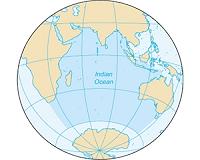 |
Boulder CO (SPX) Jul 19, 2010 Indian Ocean sea levels are rising unevenly and threatening residents in some densely populated coastal areas and islands, a new study concludes. The study, led by scientists at the University of Colorado at Boulder (CU) and the National Center for Atmospheric Research (NCAR) in Boulder, Colo., finds that the sea-level rise is at least partly a result of climate change. Sea-level rise is particularly high along the coastlines of the Bay of Bengal and the Arabian Sea, as well as the islands of Sri Lanka, Sumatra and Java, the authors found. The rise--which may aggravate monsoon flooding in Bangladesh and India--could have future impacts on both regional and global climate. The key player in the process is the Indo-Pacific warm pool, an enormous, bathtub-shaped area spanning a huge area of the tropical oceans stretching from the east coast of Africa west to the International Date Line in the Pacific. The warm pool has heated by about 1 degree Fahrenheit, or 0.5 degrees Celsius, in the past 50 years, primarily because of human-generated emissions in greenhouses gases. "Our results from this study imply that if future anthropogenic warming effects in the Indo-Pacific warm pool dominate natural variability, mid-ocean islands such as the Mascarenhas Archipelago, coasts of Indonesia, Sumatra and the north Indian Ocean may experience significantly more sea-level rise than the global average," says scientist Weiqing Han of CU and lead author of a paper published this week in the journal Nature Geoscience. While several areas in the Indian Ocean region are experiencing sea-level rise, sea level is lowering in other areas. The study indicated that the Seychelles Islands and Zanzibar off Tanzania's coastline show the largest sea level drop. "Global sea-level patterns are not geographically uniform," says NCAR scientist Gerald Meehl, a co-author of the paper. "Sea-level rise in some areas correlates with sea-level fall in other areas." Funding for the research came from the National Science Foundation (NSF), NCAR's sponsor, as well as the Department of Energy and NASA. "This work is a step forward towards getting improved estimates of sea-level changes in one of the most heavily populated regions of the globe," says Eric Itsweire, director of NSF's physical oceanography program. "Quantifying the heat and fresh water balance, as well as the large-scale circulation changes, in the Indo-Pacific warm pool through the use of observations and numerical models is crucial to understanding the subtle sea-level changes occurring in that region," Itsweire says. The patterns of sea-level change are driven by the combined enhancement of two primary atmospheric wind patterns known as the Hadley circulation and the Walker circulation. The Hadley circulation in the Indian Ocean is dominated by air currents rising above strongly heated tropical waters near the equator and flowing poleward at upper levels, then sinking to the ocean in the subtropics and causing surface air to flow back toward the equator. The Indian Ocean's Walker circulation causes air to rise and flow westward at upper levels, sink to the surface and then flow eastward back toward the Indo-Pacific warm pool. "The combined enhancement of the Hadley and Walker circulation form a distinct surface wind pattern that drives specific sea-level patterns," Han says. In their paper, the authors write that "our new results show that human-caused changes of atmospheric and oceanic circulation over the Indian Ocean region--which have not been studied previously--are the major cause for the regional variability of sea-level change." The study indicates that in order to anticipate global sea-level change, researchers also need to know the specifics of regional sea-level changes. "It is important for us to understand the regional changes of the sea level, which will have effects on coastal and island regions," says NCAR scientist Aixue Hu. The research team used several sophisticated ocean and climate models for the study, including the Parallel Ocean Program--the ocean component of the widely used Community Climate System Model, which is supported by NCAR and the U.S. Department of Energy (DOE). In addition, the team used a wind-driven, linear ocean model for the study. The complex circulation patterns in the Indian Ocean may also affect precipitation by forcing even more atmospheric air down to the surface in Indian Ocean subtropical regions than normal, Han speculates. "This may favor a weakening of atmospheric convection in subtropics, which may increase rainfall in the eastern tropical regions of the Indian Ocean and drought in the western equatorial Indian Ocean region, including east Africa," Han says.
Share This Article With Planet Earth
Related Links National Science Foundation Water News - Science, Technology and Politics
 Indian Ocean levels rising, study shows
Indian Ocean levels rising, study showsBoulder, Colo. (UPI) Jul 15, 2010 Indian Ocean sea levels are rising unevenly, posing a threat to residents in some densely populated coastal areas and islands, a new study says. The study, led by researchers at the University of Colorado in Boulder and the National Center for Atmospheric Research, attributes the sea-level rise in part to climate change. Along the coasts of the northern Indian Ocean, seas have ri ... read more |
|
| The content herein, unless otherwise known to be public domain, are Copyright 1995-2010 - SpaceDaily. AFP and UPI Wire Stories are copyright Agence France-Presse and United Press International. ESA Portal Reports are copyright European Space Agency. All NASA sourced material is public domain. Additional copyrights may apply in whole or part to other bona fide parties. Advertising does not imply endorsement,agreement or approval of any opinions, statements or information provided by SpaceDaily on any Web page published or hosted by SpaceDaily. Privacy Statement |